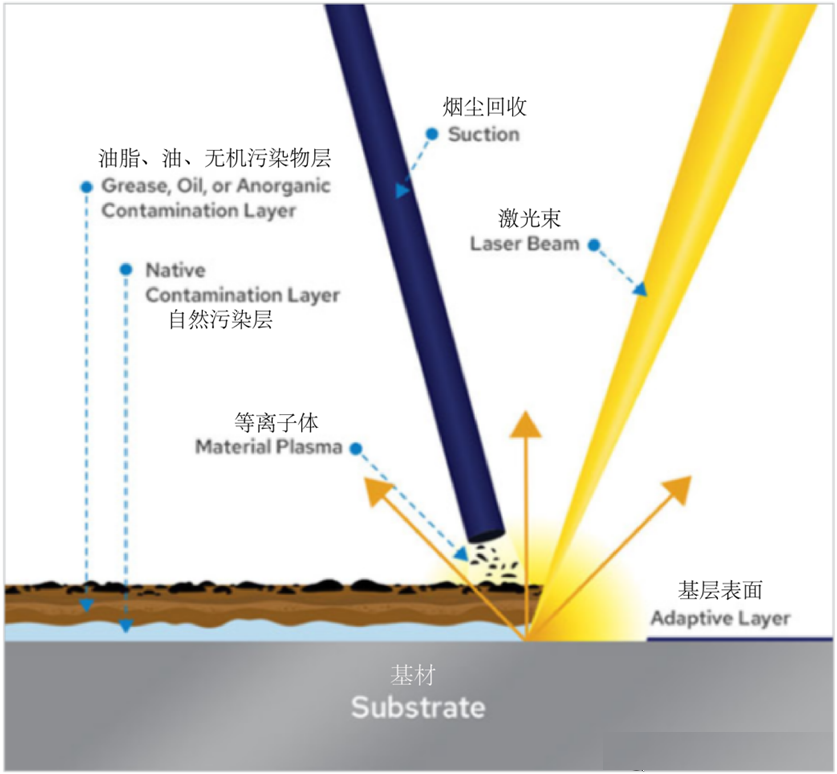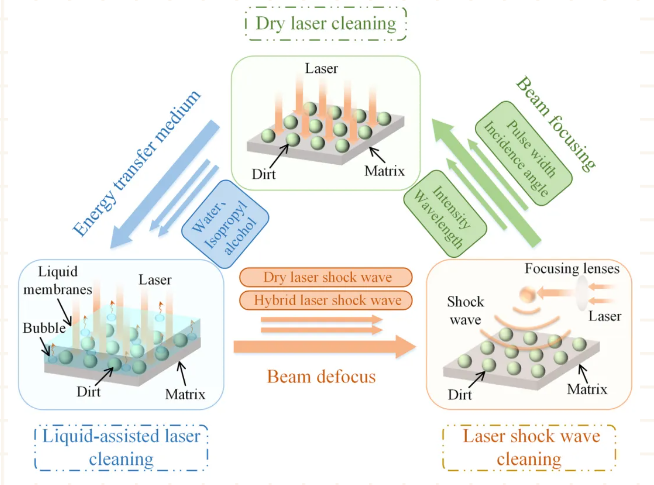The principle, types and applications of laser cleaning technology
Laser cleaning technology is a successful application of laser technology in the engineering field. Its basic principle is to utilize the high energy density of laser to interact with the contaminants adhering to the substrate of the workpiece, causing them to separate from the substrate in the form of instantaneous thermal expansion, melting, and gas evaporation. Laser cleaning technology is characterized by high efficiency, environmental friendliness, and energy conservation. It has been successfully applied in fields such as tire mold cleaning, aircraft body paint removal, and cultural relic restoration.
Traditional cleaning technologies include mechanical friction cleaning (sandblasting cleaning, high-pressure water jet cleaning, etc.), chemical corrosion cleaning, ultrasonic cleaning, dry ice cleaning, etc. These cleaning technologies have been widely used in various industries. For example, sandblasting cleaning can remove metal rust spots, metal surface burrs, and three-proof varnish on circuit boards by selecting abrasives of different hardness. Chemical corrosion cleaning technology is widely used in the cleaning of oil stains on equipment surfaces, scale in boilers, and oil pipelines. Although these cleaning technologies have been well developed, they still have some problems. For instance, sandblasting cleaning can easily cause damage to the treated surface, and chemical corrosion cleaning can cause environmental pollution and corrosion of the cleaned surface if not handled properly. The emergence of laser cleaning technology represents a revolution in cleaning technology. It takes advantage of the high energy density, high precision, and efficient transmission of laser energy, and has obvious advantages over traditional cleaning technologies in terms of cleaning efficiency, cleaning precision, and cleaning location. It can effectively avoid environmental pollution caused by chemical corrosion cleaning and other cleaning technologies, and will not cause damage to the substrate.
The principle of laser cleaning
So what is laser cleaning? Laser cleaning is a process where a laser beam is used to remove material from the surface of a solid (or sometimes a liquid). At low laser flux, the material is heated by the absorbed laser energy and evaporates or sublimates. At high laser flux, the material usually turns into plasma. Usually, laser cleaning refers to removing material using pulsed lasers, but if the laser intensity is high enough, a continuous wave laser beam can be used to ablate the material. The excimer laser of deep ultraviolet light is mainly used for optical ablation. The laser wavelength used for optical ablation is approximately 200nm. The depth of absorption of the laser energy and the amount of material removed by a single laser pulse depend on the optical properties of the material, as well as the laser wavelength and pulse length. The total mass ablated from the target by each laser pulse is usually called the ablation rate. The scanning speed of the laser beam and the coverage of the scanning line, etc., will significantly affect the ablation process.
Types of Laser Cleaning Technology
1) Laser dry cleaning: Dry laser cleaning refers to the direct irradiation of the cleaning workpiece by pulsed laser, causing the base or surface contaminants to absorb energy and increase in temperature, resulting in thermal expansion or thermal vibration of the base, thereby separating the two. This method can be roughly divided into two situations: one is that the surface contaminants absorb laser energy and expand; the other is that the base absorbs laser energy and generates thermal vibration. In 1969, S.M. Bedair et al. discovered that various surface treatment methods such as heat treatment, chemical corrosion, and sandblasting cleaning all have different drawbacks. At the same time, the high energy density after laser focusing can make the phenomenon of material surface evaporation possible, which enables the possibility of non-destructive cleaning of the material surface. Through experiments, it was found that using a ruby Q-switched laser with a power density of 30 MW/cm2 can achieve the cleaning of silicon material surface contaminants without damaging the base, and for the first time, laser dry cleaning of material surface contaminants was realized. The overall rate can be expressed by the rate of detachment of film layer fragments, as follows:
In the formula, ε represents the laser pulse energy index, h represents the thickness index of the pollutant film layer, and E represents the elastic modulus index of the film layer.
2) Laser Wet Cleaning: Before the workpiece to be cleaned is exposed to the pulsed laser, a surface pre-coating liquid film is applied. Under the action of the laser, the temperature of the liquid film rises rapidly and vaporizes. At the moment of vaporization, an impact wave is generated, which acts on the pollutant particles and causes them to detach from the substrate. This method requires that the substrate and the liquid film do not react with each other, thus limiting the range of applicable materials. In 1991, K. Imen et al. addressed the problem of residual sub-micron particle pollutants on the surfaces of semiconductor wafers and metal materials after traditional cleaning methods were used, and studied the application of coating a film on the surface of the material substrate that can efficiently absorb laser energy. Subsequently, using a CO2 laser, the film absorbed the laser energy and rapidly increased in temperature and boiled, generating explosive vaporization, which removed the pollutants from the substrate surface. This cleaning method is called laser wet cleaning.
3) Laser Plasma Shock Wave Cleaning: Laser plasma shock waves are generated when the laser irradiates the air medium and causes a spherical plasma shock wave to be formed. The shock wave acts on the surface of the workpiece to be cleaned and releases energy to remove the pollutants. The laser does not act on the substrate, thus not causing damage to the substrate. The laser plasma shock wave cleaning technology can now clean particles with diameters of several tens of nanometers, and there are no restrictions on the laser wavelength. The physical principle of plasma cleaning can be summarized as follows: a) The laser beam emitted by the laser is absorbed by the contamination layer on the treated surface. b) The large amount of absorption forms a rapidly expanding plasma (highly ionized unstable gas) and generates an impact wave. c) The impact wave causes the pollutants to fragment and be removed. d) The pulse width of the light pulse must be short enough to avoid thermal accumulation that could damage the treated surface. e) Experiments have shown that when there are oxides on the metal surface, plasma is generated on the metal surface. Plasma is only generated when the energy density exceeds the threshold, which depends on the removed contamination layer or oxide layer. This threshold effect is very important for effective cleaning while ensuring the safety of the substrate material. The appearance of plasma also has a second threshold. If the energy density exceeds this threshold, the substrate material will be damaged. To perform effective cleaning while ensuring the safety of the substrate material, the laser parameters must be adjusted according to the situation to ensure that the energy density of the light pulse is strictly between the two thresholds. In 2001, J. M. Lee et al. utilized the characteristic that high-power lasers produce plasma shock waves when focused, and used a pulse laser with an energy density of 2.0 J/cm2 (much higher than the damage threshold of silicon wafers) to irradiate parallel to the silicon wafer, successfully cleaning 1 μm tungsten particles adsorbed on the surface of the silicon wafer. This cleaning method is called laser plasma shock wave cleaning, and strictly speaking, laser plasma shock wave cleaning is a type of dry laser cleaning. The original purpose of these three laser cleaning technologies was to clean the tiny particles on the surface of semiconductor wafers. It can be said that laser cleaning technology emerged with the development of semiconductor technology. However, laser cleaning technology has been continuously applied to other fields, such as tire mold cleaning, aircraft skin paint removal, and artifact surface restoration. While under laser radiation, inert gas can be blown onto the substrate surface. When the contaminants are peeled off from the surface, they will be immediately blown off the surface by the gas to avoid re-pollution and oxidation of the surface.
The application of laser cleaning technology
1) In the semiconductor field, the cleaning of semiconductor wafers and optical substrates involves the same process, which is to process the raw materials into the required shapes through cutting, grinding, etc. During this process, particulate contaminants are introduced, which are difficult to remove and cause severe repeated contamination problems. The contaminants on the surface of semiconductor wafers can affect the quality of circuit board printing, thereby shortening the lifespan of semiconductor chips. The contaminants on the surface of optical substrates can affect the quality of optical devices and coatings, and may lead to uneven energy distribution, shortening the lifespan. Since laser dry cleaning is prone to causing damage to the substrate surface, this cleaning method is less used in the cleaning of semiconductor wafers and optical substrates. Laser wet cleaning and laser plasma shock wave cleaning have more successful applications in this field. Xu Chuanyi et al. studied the deposition of micro-scale special magnetic paint on the surface of ultra-smooth optical substrates as a dielectric film, and then used a pulsed laser for cleaning. The cleaning effect was good, although the number of impurity particles per unit area increased, the size and coverage area of the impurity particles were significantly reduced. This method can effectively clean the micro-scale impurity particles on the surface of ultra-smooth optical substrates. Zhang Ping studied the influence of working distance and laser energy on the cleaning effect of different particle size contaminants in laser plasma cleaning technology. The experimental results showed that for polystyrene particles on conductive glass substrates, the optimal working distance for energy of 240 mJ was 1.90 mm. As the laser energy increased, the cleaning effect improved significantly, and large particle contaminants were easier to clean.
2) In the metal material field, the cleaning of metal material surfaces is different from the cleaning of semiconductor wafers and optical substrates. The contaminants to be cleaned belong to the macroscopic category. The contaminants on the surface of metal materials mainly include oxide layer (rust layer), paint layer, coating, and other attachments, and can be classified into organic contaminants (such as paint layer, coating) and inorganic contaminants (such as rust layer). The cleaning of metal material surface contaminants is mainly to meet the requirements of subsequent processing or use, such as removing about 10 μm of oxide layer from the surface of titanium alloy parts before welding, removing the original paint coating on the skin surface during aircraft major repairs to facilitate re-spraying, and regularly cleaning the rubber particles attached to the rubber tire mold to ensure the cleanliness of the surface and the quality and lifespan of the mold. The damage threshold of metal materials is higher than that of their surface contaminants’ laser cleaning threshold. By selecting an appropriate power laser, a better cleaning effect can be achieved. This technology has been maturely applied in some fields. Wang Lihua et al. studied the application of laser cleaning technology in the treatment of oxide skins on the surfaces of aluminum alloys and titanium alloys. The research results showed that using a laser with an energy density of 5.1 J/cm2 could clean the oxide layer on the surface of A5083-111H aluminum alloy while maintaining the good quality of the substrate, and using a pulsed laser with an average power of 100 W in a scanning manner could effectively clean the oxide layer on the surface of titanium alloys and improve the hardness of the material surface. Domestic companies such as Ruike Laser, Daqu Laser, and Shenzhen Chuangxin have developed laser cleaning equipment that has been widely used for cleaning rubber molds such as tires, metal rust layers, and oil stains on the surface of components.
3) In the field of cultural relics, the cleaning of metal and stone relics and paper surfaces is necessary to remove contaminants such as dirt and ink stains that appear on their surfaces due to their long history. These contaminants need to be removed to restore the relics. For paper works such as calligraphy and paintings, when stored improperly, mold grows on their surfaces and forms spots. These spots seriously affect the original appearance of the paper, especially for paper with high cultural or historical value, which will affect its appreciation and protection. Zhao Ying et al. studied the feasibility of using ultraviolet laser to clean mold spots on paper scrolls. The experimental results showed that using a laser with an energy density of 3.2 J/mm2 to scan once could remove thin spots, and scanning twice could completely remove the spots. However, if the laser energy used is too high, it will damage the paper scroll while removing the spots. Zhang Xiaotong et al. successfully restored a gilded bronze relic using the laser vertical irradiation liquid film method. Zhang Licheng et al. used laser cleaning technology in the restoration of a Han Dynasty painted female pottery figurine. Yuan Xiaodong et al. studied the effect of laser cleaning technology in the cleaning of stone relics and compared the damage to the sandstone body before and after cleaning, as well as the cleaning effects of ink stains, smoke pollution, and paint pollution.
Conclusion: Laser cleaning technology is a relatively advanced technique, with broad research and application prospects in high-precision fields such as aerospace, military equipment, and electronic and electrical engineering. Currently, laser cleaning technology has been successfully applied in some areas, thanks to its efficient, environmentally friendly, and excellent cleaning performance. Its application areas are gradually expanding. The development of laser cleaning technology has not only been maturely applied in areas such as paint removal and rust removal, but also there have been reports of using laser to clean the oxide layer on metal wires in recent years. The expansion of existing application fields and the development of new fields are the foundation of the development of laser cleaning technology. The research and development of new laser cleaning equipment and the development of new laser cleaning equipment will show differentiation, resulting in various functions. In the future, achieving fully automatic laser cleaning through cooperation with industrial robots is also achievable. The development trend of laser cleaning technology is as follows:
(1) Strengthening the research on laser cleaning theory to guide the application of laser cleaning technology. After reviewing a large number of documents, it is found that there is no mature theoretical system supporting laser cleaning technology, and most studies are based on experiments. Establishing a laser cleaning theoretical system is the foundation for the further development and maturity of laser cleaning technology.
(2) Expansion of existing application fields and new application fields. Laser cleaning technology has been successfully applied in areas such as paint removal and rust removal, and there have been reports of using laser to clean the oxide layer on metal wires in recent years. The expansion of existing application fields and the development of new fields are fertile soil for the development of laser cleaning technology.
(3) Research and development of new laser cleaning equipment. The development of new laser cleaning equipment will show differentiation. One type is equipment with certain universality covering multiple application fields, such as one device can simultaneously achieve paint removal and rust removal functions. The other type is specialized equipment for specific needs, such as designing specific fixtures or optical fibers to achieve the function for cleaning pollutants in small spaces. Through cooperation with industrial robots, fully automatic laser cleaning is also a popular application direction.
Post time: Jul-17-2025


















